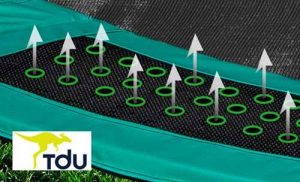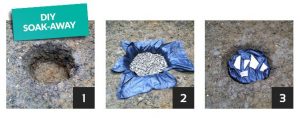Frequently Asked Questions
IN-GROUND TRAMPOLINES – YOUR QUESTIONS ANSWERED
We’re here to help make your in-ground trampoline installation run as smoothly as possible. Although perhaps daunting at first, installing a Capital Play In-Ground Trampoline is really very simple, it just takes a bit of muscle & time. We have listed some of our most frequently asked questions below.
If you need further assistance or would like a free estimate for us to install your AZ in-ground trampoline for you please email us at [email protected] or call us free at:
COMMON QUESTIONS
Statistically, most serious trampoline accidents happen when children fall through an open zip/damaged net or fall off while climbing up the ladder to access the trampoline. These risks are negated with an in-ground trampoline.
The look amazing! In-ground trampolines are designed to work with your garden design unlike traditional trampolines which can be an eye-sore in a garden. Above ground trampolines take up a significant amount of space and are immediately visible in a garden. For those conscious about the presentation and look of their garden, this is a significant drawback. This is not a problem with in-ground trampolines as their lower profile makes them less obvious, or indeed hard to spot at all – they easily blend in with the surrounding landscape.
Freedom to play, more fun. Kids can run on and off the trampoline at will and play many more creative games. There’s no net or platform to interfere with their enjoyment. Parents need not supervise as much as issues of ‘getting on’ and ‘getting off’ the trampoline are removed.
No fear of being enclosed. Young kids sometimes get frightened being zipped inside a net away from their mom or dad. An in-ground allows parents and children to interact more – mom and dad can stay in close contact at all times.
Better bounce. The trampoline frame is buried firmly in the ground allowing no movement of the frame. On a traditional trampoline energy can be dissipated as the frame moves a little when you bounce. This does not occur on an in-ground trampoline resulting in a better quality bounce.
Quieter. In-grounds are less noisy because the frame (which can squeak) is buried underground and the retaining wall keeps the frame very rigid. Trapped air escapes silently through the pads.
Lower maintenance cost. In-ground trampolines cost less to maintain if you do not have a net which is the most frequently required and costly replacement part.
Less damage risk. In-ground trampolines eliminate the possibility of damage occurring because your trampoline cannot be blown away in high winds.
Great for parents. Climbing up a small ladder and through a small zip can be somewhat off-putting for an adult. It’s much easier to just walk onto the trampoline. You’ll love it!
Our kits include everything you need – a top specification trampoline designed specifically for in-ground installation, retaining wall and vented surround pads for a superb bounce and no ‘pad slap’ noise.

You can also use vent ducts using 4 inch flexible ducting hose coming from under the trampoline to somewhere on the outside of trampoline. The problem here however is to decide where to put the ducting so it doesn’t become an unsightly hazard near the trampoline.
The actual frame of the trampoline is held very firmly when it’s in the ground and therefore minimal energy is dissipated through small movements in the frame that you get with an above ground trampoline. This helps to improve the bounce of an in-ground trampoline.
When you bounce on a trampoline, the air underneath needs somewhere to escape. On an in-ground trampoline the only place for the trapped air to be expelled is through the springs and under the safety surround pad. The trapped air can force the pads up which then slap down against the trampoline mat. This noise can be loud and off putting – pad slap noise has even been known to cause neighbourly disputes!
Our excellent solution is to use special vented pads which allow air to easily escape through the hole vents in the padding which completely eliminates pad slap noise. Check out this video:
Easy to use instructions are provided and telephone/email help is always available from our qualified staff. Contact our Phoenix in-ground trampoline installation company to find out more.
INSTALL QUESTIONS
In difficult or hard soil, you may wish to hire an electric vibration dampened breaker from your local tool hire shop. They’re not expensive to hire, easy to use and will greatly assist in digging out your soil.
If you want to hire a mini digger, this is a good option, but can be expensive, you may have access problems and they can cause damage to your lawn/garden. Also do not underestimate the difficulty in operating a mini digger. Whatever your hire shop might say, mini diggers are not that easy to operate, especially when your trying to dig quite a precise round hole. You’re best to always hire an experienced ‘man with a digger’.
If however you have clay or chalky soil then rain water can collect in the bottom of the pit. It’s advisable to put a simple soak-away in the very bottom of the hole you have dug. This is a simple task and usually sufficient to provide sufficient drainage for you. See next FAQ below.
If you’re looking to dig your trampoline into the ground where it’s particularly wet, liable to flooding or you have a high water table, you should contact a drainage expert who can advise on the best solution. Typically this could be to dig in drainage channels away from the hole to a lower level in your garden.
If you have any doubt about drainage issues or having a high water table, then we strongly recommend you dig a trial hole 3ft deep and wait 24 hours to see if water collects in the trial hole.
The enclosure system is an optional extra which can be purchased with the Jump Shack In-ground Kit. It’s easy to assemble and take down. You may decide to start with a net if you have younger children with a view of taking it down as they get older.

- At the bottom of your newly excavated trampoline hole dig an additional hole that is about 2ft in diameter and about 2ft in depth.
- Install in the hole a permeable fabric weed membrane (available at most DIY stores) and fill with crushed rock or any other type of 1/2″ or minus material. The fabric will stop the hole from silting up and allow water to collect and drain properly.
- Finally wrap the fabric over the top of the crushed rock material and lay something on top to seal it up. You now have a drainage-pit and a place for your water to drain.

